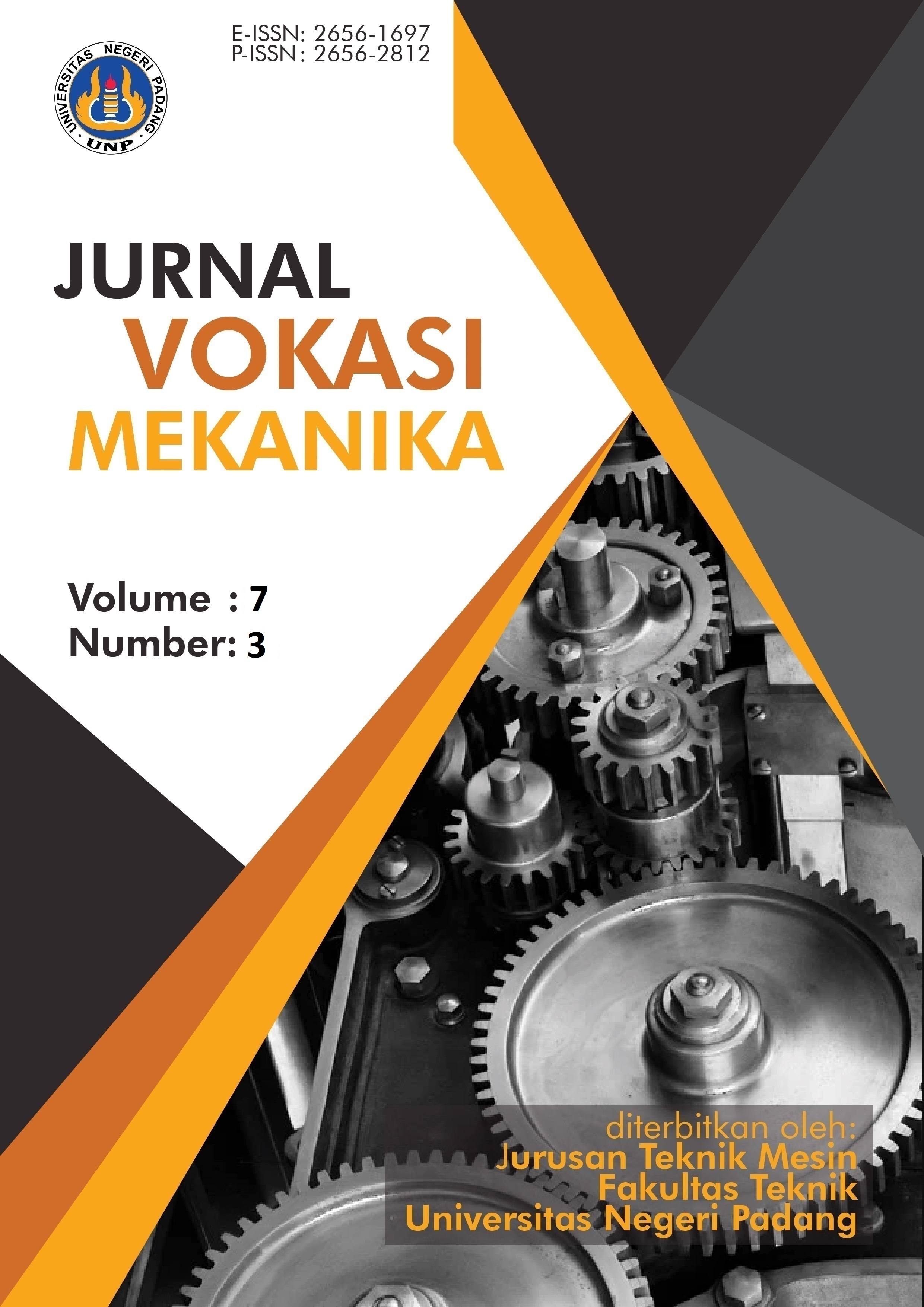Numerical Analysis of Coupled Thermal-Mechanical on Drum Brakes
Abstract
Drum brakes are one of the crucial components in motor vehicle braking systems, particularly in motorcycles, due to their advantages in production cost and resistance to environmental contamination. However, this type of brake has limitations in dissipating heat during braking, which can lead to temperature accumulation, thermal deformation, and reduced braking efficiency. This study aims to analyze the thermo-mechanical performance of drum brakes with various cooling groove designs (solid, straight-grooved, and slant-grooved) using a numerical method based on Finite Element Analysis (FEA) in ANSYS Workbench. The analysis was conducted in a transient manner, both thermally and structurally, to evaluate temperature distribution and total deformation for each design. The results show that the slant-grooved drum brake design yields the lowest temperature distribution and total deformation values, especially at high braking speeds, with a temperature distribution of 56.899 °C and total deformation of 17.67 × 10⁻³ mm. These findings indicate that groove design significantly affects the heat dissipation and structural deformation performance of the brake system. The study concludes that the slant-grooved design is superior in reducing heat and deformation, thereby offering the potential to improve braking safety and efficiency.
References
Agbeleye, A. A., Esezobor, D. E., Balogun, S. A., Agunsoye, J. O., Solis, J., & Neville, A. (2020). Tribological properties of aluminium-clay composites for brake disc rotor applications. Journal of King Saud University - Science, 32(1), 21–28. https://doi.org/10.1016/j.jksus.2017.09.002
Aulia Putra, M. R., Pratama, P. S., & Prabowo, A. R. (2021). Failure of Friction Brake Components against Rapid Braking Process: A Review on Potential Challenges and Developments. Transportation Research Procedia, 55, 653–660. https://doi.org/10.1016/j.trpro.2021.07.096
Beer, F. P., Johnston, E. R., Dewolf, J. T., & Mazurek, D. F. (2020). ISE Statics and Mechanics of Materials.
Bird, J., & Ross, C. (2012). Mechanical Engineering Principles. In Mechanical Engineering Principles. https://doi.org/10.4324/9780203121146
Choy, H. Y., Siaw, M. G., & Pung, K. Q. (2023). Design and Analysis of Brake Drum using Finite Element Analysis. Journal of Physics: Conference Series, 2609(1). https://doi.org/10.1088/1742-6596/2609/1/012011
Dzikrullah dkk. (2017). 1. Analisa Gesekan Pengereman Hidrolis. Prosiding SNATIF, 667–678.
Hafizh, N. N., Yunus, M., & Wisnaningsih. (2022). Pengaruh Gaya Rem Cakram (Disc Brake), Ketebalan, Cakram, Minyak Rem pada Sepeda Motor Honda Beat Pop 2015, 110 CC. Jurnal Tekayasa Teknologi Dan Sains, 6(2), 83–87.
Hudz, H., & Hlobchak, M. (2023). The influence of important factors on the distribution of heat flows in elements of drum brakes of vehicles. Transport Technologies, 2023(1), 83–89. https://doi.org/10.23939/tt2023.01.083
Johnston, B. I., & Cornwell, I. M. I. (n.d.). S TAT I C S | D Y N A M I C S for ENGINEERS.
Kementrian Ketenagakerjaan. (2019). Melakukan Perawatan Sistem Pengereman. 1–46.
Khatir, T., Bouchetara, M., Derrar, K., Djafri, M., Khatir, S., & Abdel Wahab, M. (2022). Thermomechanical Behavior of Brake Drums under Extreme Braking Conditions. Computers, Materials and Continua, 72(2), 2259–2273. https://doi.org/10.32604/cmc.2022.020879
Kiran, C. S., Ravi Kumar, M., Reddy, P. S., Venkatesh, T., & Professor, A. (2020). Modelling and Analysis of Brake Drum using ANSYS Workbench. 2–6.
Lapisa, R., Fernandez, D., Tarihoran, C., Milana, Arif, A., Purwantono, & Jasman. (2022). Experimental Study of the Effect of Brake Drum Cooling Grooves on Motorcycle Braking Performance. EUREKA, Physics and Engineering, 2022(3), 69–77. https://doi.org/10.21303/2461-4262.2022.001983
Moran, M. J., & Shapiro, H. N. (1993). Fundamentals of Engineering Thermodynamics, Second Edition. In European Journal of Engineering Education (Vol. 18, Issue 2). https://doi.org/10.1080/03043799308928176
Physics for Scientists & Engineers with Modern Physics Douglas C . Giancoli. (n.d.-a).
Physics for Scientists & Engineers with Modern Physics Douglas C . Giancoli. (n.d.-b).
Premono, A., Kholil, A., Hidayat, H., & Saputra, D. (2022). Pengembangan Perangkat Lunak Elemen Hingga untuk Keperluan Pendidikan. Semesta Teknika, 25(1), 1–7. https://doi.org/10.18196/st.v25i1.13632
Rachmadi, D. T. (2014). Kajian Unjuk Kerja Sistem Pengereman Depan Dengan Cakram Dan Belakang Dengan Tromol Pada Sepeda Motor Gas Wisanggeni. Institut Teknologi Sepuluh November, 1–75.
Ridwan, R., Riyantono, A., & Irawan, R. (2023). Pengaruh Massa dan Kecepatan Kendaraan Terhadap Suhu Pada Rem Drum. Jurnal Teknik Mesin Sinergi, 21(2), 337–345. https://doi.org/10.31963/sinergi.v21i2.4600
Yang, D., Yu, Z., Zhang, L., & Cheng, W. (2018). Modal Analysis of Automobile Brake Drum Based on ANSYS Workbench. Proceedings of the 2017 7th International Conference on Mechatronics, Computer and Education Informationization (MCEI 2017), 75(Mcei), 608–612. https://doi.org/10.2991/mcei-17.2017.129
Submitted
Copyright (c) 2025 Jurnal Vokasi Mekanika (VoMek)

This work is licensed under a Creative Commons Attribution 4.0 International License.








.svg_.png)


